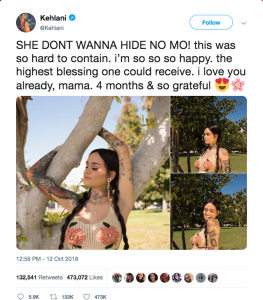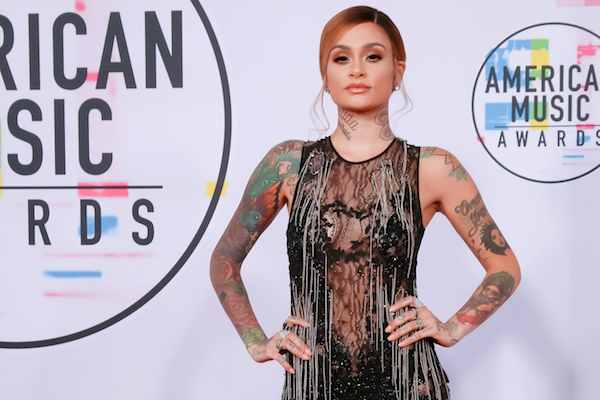It’s been quite a year for Kehlani. After coming out as queer earlier this year, things seemed to only continue for the singer. Just earlier this month, she publicly posted about her pregnancy, sharing her joy with her followers.
But the public’s response went beyond excitement and well wishes. Many were quick to feel confusion and turn to erasure. The assumption that Kehlani, as a queer person, couldn’t or wouldn’t become pregnant is something that is often assumed. The erasure of queerness when it comes to family planning and pregnancy is an issue of how we talk about and frame sexual education. And this speaks to how necessary it is to make sure that we’re not only including, but centering queer identity within sex education.
Kehlani’s pregnancy news threw many people off balance because so much of sex education is framed through a heterosexual lens. The assumption that anyone that engages in any kind of sex would only subscribe to the assumption that people who are queer wouldn’t. But there’s also something to be said when it comes to how queer identity is erased when we talk about family planning and pregnancy.
The queer identity erasure didn’t stop at Kehlani but extended to the child’s father as well. Though Kehlani has chosen to keep his identity anonymous, she has confirmed that he is bisexual — leading to further questions and assumptions from the public. “I started dating women before I ever dated men,” the singer said on Nicki Minaj’s Queen Radio show earlier this month. “Then I was lucky to find a partner who was a bisexual male. And he really understands my queerness and my fluidity, and I really understand his. It’s very awesome to be understood.”
 But not everyone is at a place to understand or accept fluidity of identity and sexuality. “How can she be pregnant if her partner is bisexual and doesn’t that just mean that he’s gay” were common themes that came up, over and over again, on social media. And in many ways, it’s to be expected — as a culture, we have a hard time wrapping our heads around anyone that breaks out of the norm. Many of us grew up believing that the only way to have a family was to have intercourse with someone of the “opposite” gender and carry the child to term. With Kehlani’s pregnancy announcement and follow-up declaration that the child’s father is bisexual, some confusion is bound to happen.
But not everyone is at a place to understand or accept fluidity of identity and sexuality. “How can she be pregnant if her partner is bisexual and doesn’t that just mean that he’s gay” were common themes that came up, over and over again, on social media. And in many ways, it’s to be expected — as a culture, we have a hard time wrapping our heads around anyone that breaks out of the norm. Many of us grew up believing that the only way to have a family was to have intercourse with someone of the “opposite” gender and carry the child to term. With Kehlani’s pregnancy announcement and follow-up declaration that the child’s father is bisexual, some confusion is bound to happen.
But that confusion, though it may seem innocent, is actually dangerous. It reinforces our ingrained biphobia and only strengthens assumed heteronormativity for queer people that are pregnant or involved in family planning, which only works to further push them out of these spaces and keep them from having access to vital information and care down the line.
But what exactly is biphobia? Biphobia, which is the discrimination against bisexual people, extends deep in our culture. And for bisexual men, this impacts their lives in very specific ways. While women and femme-presenting folks are able to explore their sexuality freer in our culture (leading back to the biphobic assumption that sapphic sexuality is for male enjoyment or consumption), bisexual men face deeper stigma because of their proximity to masculinity. If bisexual people face erasure from the queer community at large, bisexual men also face a certain kind of specific erasure from the community at large.
Fans were quick to dismiss the sexual identity of both Kehlani and the child’s father, assuming that because Kehlani is a cis woman and is pregnant, that her partner must be heterosexual. This is biphobia in action and reinforces the dangerous stigmas that bisexual and queer individuals face every day, but especially in spaces that relate back to sex and family.
Sex education already fails so many LGBTQ individuals because they are completely erased from the curriculum, but even fewer queer people have access to resources when it comes to family planning. Spaces that are reserved for family planning, including pregnancy, carry such preconceived ideas of what that looks like for a queer person and rarely do we allow space in mainstream narratives about queer family planning that includes a person carrying a child to term and the conceiving of them with their partner.
In erasing the sexual orientation of both Kehlani and the child’s father, we reinforce the ways that bisexual and queer people are pushed out of family planning and other vital spaces. So it’s important that we’re stepping up and speaking out about the ways that many of our conversations leave out people who are polysexual — have the capacity to love people across the spectrum of gender — which includes people who identify as pansexual, bisexual+, and/or queer.
We have to educate ourselves on how to be more inclusive and work to make the spaces that we occupy reflect that. It may begin with education, but it needs to be accompanied by action.
Kehlani and this situation is only one example of the ways that queer people have their identities pushed out of family planning conversations and spaces. But this happens to parents and would-be parents (who are queer, bisexual, or otherwise polysexual) every day. So how do we do better? Unpacking and relearning this takes time and effort. But it’s necessary that we do so because family planning and the choice is part of reproductive justice — something that affects all of us. It’s vital that we open these spaces to all people that need them, and place the work on unpacking biphobia and queerphobia from family planning spaces and conversations on us rather than on the people that are impacted by it the most.
Queerness is fluid, multi-faceted, and ever evolving. For as many people as there are, that’s how many interpretations and definitions of queer identity there are. Kehlani’s pregnancy announcement and the ways that both she and her co-parent’s sexual identity were erased and separated from their identities as parents make us aware of the ways that queerphobia raises up in conversations of parenthood and family planning. It also reinforces how necessary it is to center LGBTQ folks in sex education. Though it won’t completely eradicate queerphobia and biphobia in our culture, education is often the first step to beginning to unpack this.


